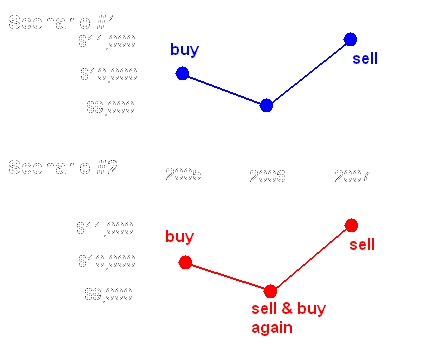Tax gain harvesting
Post on: 16 Март, 2015 No Comment

Tax gain harvesting. as opposed to tax-loss harvesting. is the process of turning unrealized long-term capital gains into realized capital gains at a specific time for tax purposes.
Contents
Overview
In general, it is considered advantageous to delay the realization of capital gains as long as possible. Consequently, tax-gain harvesting is often counter-intuitive and less frequently discussed.
Under the assumption that he/she may have more taxable income in future years, an investor might accelerate long-term capital gains. They might do so: [1]
- Up to the top of the 15% bracket, in order to take advantage of the 0% capital gains tax rate for this bracket.
- Up to the top of the ACA Net Investment Income (NII) tax threshold for their filing status, in order to avoid paying the 3.8% surtax in future years.
Consider the following scenario:
- In 2009, Alice and Bob buy 10 shares of Fund A for $100/share. Each has $1,000 basis in the fund.
- In 2012, Fund A is worth $200/share. Alice sells her shares of Fund A, realizing a $1,000 capital gain. Because Alice is in the 15% tax bracket, she owes no taxes on this gain. The next day, she repurchases 10 shares of Fund A at the same price (the ‘wash sale ‘ rule does not apply).
- In 2014, Alice and Bob are now in the 25% tax bracket (15% long term capital gains tax) and sell their shares. Fund A is worth $250/share. Alice has realized another $500 gain, incurring $75 in taxes. Bob has realized a $1,500 capital gain, incurring $225 in taxes.
Bob has incurred triple the taxes on the same capital gain by not tax-gain harvesting.
Fine points about tax gain harvesting
Regulatory
- Wash sale. The wash sale rule does not apply to tax-gain harvesting. The definition of a wash sale specifically applies it only to securities sold at a loss; securities sold at a profit may immediately be repurchased without tax consequences.
- Qualified dividends: If you hold shares less than 61 days and receive qualified dividends from those shares, they are not qualified dividends even though the fund company may claim to be qualified dividends. See Mutual Fund Ordinary Dividends for more details. Disqualification of qualified dividends may outweigh the benefit of tax gain harvesting in some cases.
Operational
- Offsetting with capital losses: Carryover losses, and losses realized during the year, must be used to offset realized gains. The tax benefits of these losses may outweigh the benefits from harvesting gains. [note 1]
- Tax planning: Utilize tax software or a tax calculator to do what-if calculations. Because of the various interactions of the income components and easy-to-make assumptions (incorrect), it is easy to go wrong here if concepts are incorrect; as evidenced by the situations below. [2]
- Partial harvesting: If you can only harvest gains on part of your holdings, it is best to harvest gains on the shares with the lowest gains. This gives you more shares with the new, higher basis, and thus more shares which can be sold for reduced gains (if the price rises) or to harvest a loss (if the price falls in a future year).














